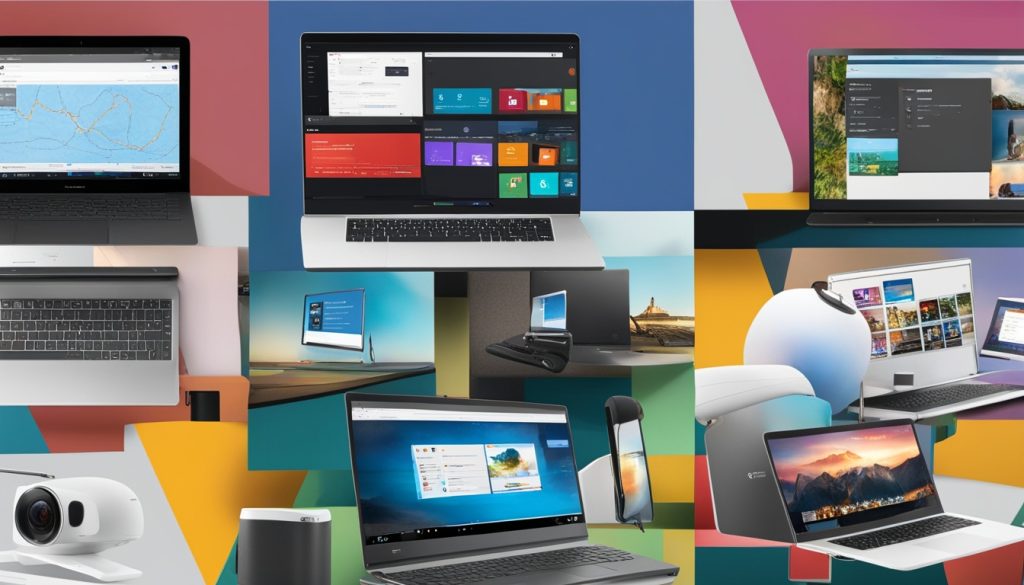Welcome to the world of online teaching and learning platforms! In recent years, these platforms have gained immense popularity, offering a plethora of innovative tools and resources to enhance the teaching experience for educators. With virtual learning becoming the new norm, these platforms have revolutionized education by providing a wide range of features and functionalities that enable educators to create engaging and interactive learning environments for their students.
Whether you’re a seasoned educator or new to the field, exploring the world of online teaching and learning platforms can open up a world of possibilities. From virtual classrooms and interactive lessons to collaborative tools, these platforms offer a wealth of resources that empower educators to deliver high-quality instruction in a digital setting.
Key Takeaways:
- Online teaching and learning platforms offer innovative tools and resources for educators.
- These platforms provide virtual classrooms, interactive lessons, and collaborative tools.
- Google Classroom, Zoom, and Pear Deck are among the best online education platforms.
- Educators can create engaging and interactive learning experiences using these platforms.
- Virtual learning platforms have revolutionized the way education is delivered.
The Benefits of Online Teaching and Learning Platforms
Online teaching and learning platforms have transformed the education landscape, providing a multitude of advantages for educators and students alike. These e-learning platforms, online course platforms, and digital learning platforms offer a range of benefits that enhance the virtual learning experience and promote educational success.
Flexibility and Convenience
One of the primary benefits of these platforms is the flexibility and convenience they afford. Students can access course materials, participate in interactive lessons, and complete assignments from anywhere with an internet connection. This eliminates geographical barriers and allows for learning to take place at the student’s own pace and schedule.
Personalized Instruction
Online teaching and learning platforms offer a wide array of courses and resources, enabling educators to deliver personalized instruction that caters to the diverse needs of their students. With extensive libraries of educational materials and tools, educators can tailor their lessons to meet individual learning styles and provide targeted support.
Enhanced Accessibility
With the rise of e-learning platforms, access to online courses has become more accessible than ever. Students have the opportunity to acquire new skills, expand their knowledge, and pursue educational opportunities that were previously out of reach. Whether it’s a professional development course, a language program, or an academic subject, online course platforms offer a breadth of options that empower students to take control of their learning journey.
Engaging and Interactive Learning Experiences
Online teaching and learning platforms provide educators with innovative tools and resources to create engaging and interactive learning experiences for their students.
These platforms incorporate various multimedia elements, such as videos, interactive quizzes, and virtual simulations, to keep students engaged and motivated. The use of gamification, discussion boards, and real-time collaboration tools fosters an interactive learning environment, promoting active participation and knowledge retention.
By embracing these digital learning platforms, educators can revolutionize their teaching methods and unlock a world of possibilities for their students. The benefits extend beyond the classroom, paving the way for lifelong learning and empowering individuals to thrive in a digital era.
Different Types of Online Teaching and Learning Tools
Online teaching and learning have revolutionized education, providing educators with a wide range of tools to enhance their virtual classrooms. There are several types of online teaching and learning tools available today, each serving a unique purpose and offering valuable benefits.
Distance Learning Platforms
Distance learning platforms like Google Classroom and Edmodo have become essential tools for educators in today’s digital era. These platforms provide a comprehensive set of tools to manage classes and engage with students online. With features such as assignment management, discussion boards, and virtual classrooms, distance learning platforms enable educators to seamlessly transition from traditional classrooms to remote teaching environments.
Online Tutoring Platforms
Online tutoring platforms such as Khan Academy and Prodigy Math Game offer personalized instruction and support to students. These platforms provide one-on-one guidance and assistance, allowing students to receive individualized attention and feedback. Online tutoring platforms are especially beneficial for students who require additional help in specific subjects or topics, as they can access expert assistance from the comfort of their own homes.
Remote Learning Tools
Remote learning tools play a vital role in facilitating communication and collaboration between educators and students. Video conferencing platforms like Zoom enable educators to connect with their students in real-time, facilitating interactive discussions and virtual lessons. Communication tools like ClassDojo provide a seamless way for educators to share updates, assignments, and feedback with students and their parents. These remote learning tools create an immersive and engaging learning environment, bridging the physical distance between educators and students.
By leveraging these different types of online teaching and learning tools, educators can enhance their teaching methods and meet the individual needs of their students. Through distance learning platforms, online tutoring platforms, and remote learning tools, educators can create dynamic and interactive virtual classrooms that inspire student engagement and foster academic success.

Top Online Teaching and Learning Platforms
When it comes to online teaching and learning, there are numerous platforms available, each offering unique features and benefits to educators and students alike. These platforms provide teachers with the communication tools, learning management systems (LMS), digital learning games, and online learning resources they need to deliver high-quality instruction and create effective learning environments. Let’s explore some of the top online teaching and learning platforms:

Google Classroom
Google Classroom is a widely-used platform that provides communication tools, such as email and video conferencing, to facilitate seamless interaction between teachers and students. With its intuitive interface, Google Classroom also offers a robust learning management system (LMS) that enables educators to organize courses, assignments, and grading efficiently.
Prodigy Math Game
To make learning math fun and engaging, platforms like Prodigy Math Game offer digital learning games that help students enhance their math skills through interactive gameplay. These games provide a playful and immersive experience, making math learning enjoyable and effective.
Online Learning Resources
Khan Academy and PBS Kids are examples of online learning resources that offer a vast range of lessons and activities to support student learning and engagement. These resources provide educators with a wealth of materials that cover various subjects, allowing for personalized instruction and learning tailored to individual student needs.
“Online teaching and learning platforms provide educators with the tools and resources they need to deliver high-quality instruction and create effective learning environments.”
With the availability of these top online teaching and learning platforms, educators have access to a wealth of communication tools, learning management systems (LMS), digital learning games, and online learning resources to enhance their teaching practices and facilitate student engagement and success.
The Role of Virtual Learning Tools in Distance Education
Virtual learning tools play a crucial role in distance education, enabling educators to create interactive and engaging learning experiences for their students. These tools provide a wide range of benefits, facilitating communication, collaboration, and lesson plan delivery.
One of the key advantages of virtual learning tools is their ability to foster communication and social interaction between students. Through features such as discussion boards, video conferencing, and real-time messaging, students can connect with their peers and engage in collaborative activities, even when physically separated.
“Virtual learning tools have transformed the way educators facilitate distance education, enabling students to actively participate, share ideas, and learn from one another.”
In addition to facilitating communication, virtual learning tools simplify the creation and delivery of lesson plans. Educators can easily design and organize course materials, upload interactive resources, and schedule assignments and assessments. These tools streamline the instructional process, allowing educators to focus more on teaching and supporting student learning.
The rapid growth of distance learning technology has led to continuous improvements in virtual learning tools. Educators now have access to a wealth of innovative features and functionalities, such as virtual whiteboards, interactive multimedia presentations, and immersive simulations. These advancements enhance the learning experience by engaging students and promoting active participation.
The Benefits of Virtual Learning Tools in Distance Education:
- Facilitate communication and social interaction among students
- Simplify lesson plan creation and delivery
- Enable active student participation and collaboration
- Provide access to innovative features and functionalities
- Enhance student engagement and learning outcomes
As distance education continues to evolve, virtual learning tools will play an increasingly vital role in supporting effective teaching and learning. With their ability to foster communication, streamline instruction, and engage students, these tools empower educators to create dynamic and impactful virtual learning environments.
Choosing the Right Online Teaching and Learning Tools
When it comes to online teaching and learning, selecting the right tools is essential for creating engaging and effective virtual classrooms. Consider the specific needs of your students and the goals of your instruction to ensure you choose the most suitable platforms. Let’s explore some popular options:
Google Classroom
Google Classroom is a widely used platform known for its comprehensive features and user-friendly interface. With Google Classroom, you can easily create and manage virtual classrooms, assign and grade assignments, and foster communication and collaboration among students. Its seamless integration with other Google tools enhances the overall virtual learning experience.
Prodigy Math Game
Prodigy Math Game is an excellent choice for engaging math learning. This interactive platform combines gameplay with educational content, making math lessons fun and exciting for students. With its adaptive learning technology, Prodigy Math Game provides personalized math practice tailored to each student’s skill level.
Pear Deck
Pear Deck is an interactive tool that promotes student engagement and participation in virtual classrooms. With Pear Deck, you can create engaging slide presentations that allow students to actively participate by answering questions, providing feedback, and collaborating with their peers. This tool encourages student interaction and enhances overall classroom dynamics.
Flipgrid
Flipgrid is a video discussion platform that facilitates student collaboration and reflection. With Flipgrid, students can record and share video responses, allowing for rich and meaningful discussions. This tool promotes active learning and fosters a sense of community within the virtual classroom.
By considering the features and benefits of each tool, educators can choose those that align with their teaching style and cater to the unique needs of their students. Remember, the right combination of online teaching and learning tools can significantly enhance the virtual learning experience for both educators and students.

Best Practices for Using Online Teaching and Learning Platforms
When it comes to online teaching and learning, following best practices and implementing effective strategies can make all the difference. By incorporating these practices into your instructional approach, you can create an engaging and dynamic online learning environment that maximizes student engagement and success.
Create Engaging and Interactive Lessons
To capture your students’ attention and promote active learning, it’s important to design lessons that are interactive and engaging. Incorporate multimedia resources such as videos, images, and interactive activities to keep students actively involved and interested in the content. Utilize online tools and platforms that allow for real-time collaboration and feedback, fostering active participation and knowledge retention.
Incorporate Multimedia Resources
Make use of a variety of multimedia resources to enhance your lessons and cater to different learning styles. Embed videos, infographics, and interactive simulations to provide visual and hands-on experiences. Utilize audio recordings or podcasts to deliver content in alternative formats. By integrating multimedia resources, you can create a multi-sensory learning experience that appeals to a wider range of students.
Provide Opportunities for Student Collaboration and Participation
“Education is not the filling of a pail, but the lighting of a fire.” -William Butler Yeats
Encourage collaboration and interaction among your students by creating opportunities for group work, discussions, and peer feedback. Utilize online discussion boards, virtual breakout rooms, and collaborative document editing tools to foster student engagement and promote active learning. By allowing students to share ideas, collaborate on projects, and learn from each other, you can create a dynamic and inclusive online learning community.
Establish Regular Communication and Provide Timely Feedback
Communication and feedback are essential in an online learning environment. Establish regular channels of communication with your students, whether through email, messaging apps, or discussion forums, to address their questions, provide guidance, and offer support. Additionally, provide timely and constructive feedback on student assignments, assessments, and participation to help them gauge their progress and make necessary improvements. Timely feedback plays a crucial role in facilitating student learning and growth.

By following these best practices and implementing effective strategies, educators can empower their students to thrive in the online learning environment. The utilization of online teaching and learning platforms, combined with these practices, creates an optimized learning experience that fosters student engagement, collaboration, and success.
Conclusion
Online teaching and learning platforms have revolutionized the field of education, providing educators with innovative tools and resources to create engaging and effective virtual learning experiences. These platforms offer a wide range of features and benefits, including virtual classrooms, interactive lessons, and collaborative tools, that enable educators to meet the diverse needs of their students.
By embracing the power of virtual learning tools, educators can effectively deliver high-quality instruction and support student learning in a distance education setting. These online platforms have transformed the way education is delivered, making learning accessible anytime and anywhere. From interactive lessons to virtual classrooms, these platforms have opened up new possibilities for educators and students alike.
As technology continues to advance and online teaching and learning platforms evolve, the future of education looks promising. These platforms provide endless opportunities for educators to engage with students, personalize instruction, and create meaningful learning experiences. With the continuous growth of online teaching and learning platforms, the possibilities for innovative education techniques are only expanding, creating a bright future for educators and students in the realm of distance learning.





No comments! Be the first commenter?